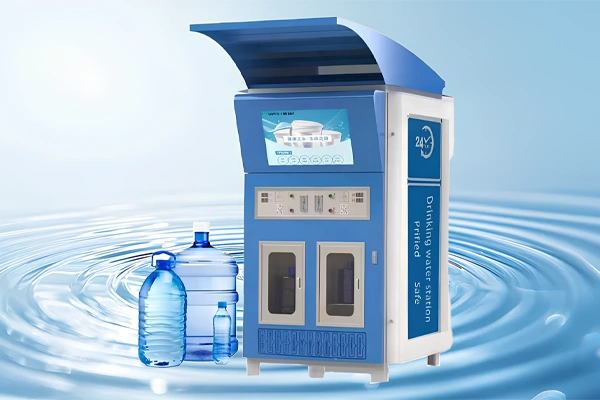🚰 What Is a Water Vending Machine?
A water vending machine is essentially a compact, self-contained water treatment plant that’s been streamlined for public use. These innovative machines are typically connected to the central water supply system and equipped with multiple filtration stages. Think of them as miniature water purification factories that happen to occupy less than 1 square meter of space! 5
You’ll find these convenient stations placed in residential communities, convenience stores, markets, offices, and schools – anywhere people need affordable access to clean drinking water. 6 The beauty of these systems is their dual function: they both treat water and dispense it automatically, usually operating 24/7 for ultimate convenience.

⚙️ How Does a Water Vending Machine Work?
Ever wonder what’s happening inside that metal cabinet when you’re filling your container? Let me break down the fascinating purification process:
The journey begins when municipal water enters the system. The first line of defense is usually a cartridge mechanical filter with a polypropylene cartridge that removes large particles like silt, rust, and sand that might be present in tap water.
Next, the water passes through an activated carbon filter that reduces chlorine content (which can damage membrane elements) and organic substances that might form mucus in the filtration layers.
The third and most crucial stage is the reverse osmosis membrane, which removes up to 99.8% of all impurities – including viruses, bacteria, heavy metal ions, and pesticides. This technology is currently the most advanced membrane treatment used in automatic water dispensers. 6
After reverse osmosis, some systems include a calcite media filter to adjust pH levels and add beneficial calcium ions through natural mineralization. A carbon post-filter then further improves the water’s taste and odor.
Finally, right before dispensing, many quality systems use ultraviolet disinfection as a final safeguard against microorganisms.
The entire process transforms ordinary tap water into premium drinking water that meets or exceeds most bottled water standards!
Here’s a quick overview of the typical purification stages:
| Step | Process | Function |
|---|---|---|
| 1 | Mechanical Filtration | Removes large particles (silt, rust, sand) |
| 2 | Activated Carbon Filter | Reduces chlorine and organic substances |
| 3 | Reverse Osmosis Membrane | Removes 99.8% of impurities including microbes |
| 4 | Mineralization | Adjusts pH and adds beneficial minerals |
| 5 | Post-Carbon Filter | Improves taste and odor |
| 6 | UV Disinfection | Eliminates microorganisms before dispensing |
🔧 Key Components of a Quality Water Dispenser
When considering a commercial water vending machine, whether for use or investment, it’s helpful to understand what sets apart quality models. A good unit consists of three main systems:
The water purification unit includes all those filtration stages we just discussed: mechanical filtration, chlorine removal, color reduction, softening, reverse osmosis, pH correction, taste improvement, mineralization, and UV disinfection.
The water dispensing unit is the user interface – the terminal where customers place and fill their containers. Most machines accommodate various plastic bottles from 0.5 to 18.9 liters.
The payment system is what makes it a true commercial water dispenser machine. This typically includes a bill acceptor, coin mechanism, and card reader for magnetic cards or RFID technology. Some newer models even support mobile payment options!
Additional components might include:
-
Storage tanks for purified water
-
Monitoring systems that track water quality and usage
-
Protective housing that’s durable and weather-resistant
-
Display screens for instructions and promotions
💧 Can You Trust the Water Quality?
When water comes from a vending machine instead of a sealed bottle, how can you be sure it’s safe?
A study of 95 machines found purification greatly improved water quality (turbidity, chloride, bacteria). However, maintenance and sanitation varied widely between operators—making provider choice crucial.
Quality machines ensure safety with:
- Automatic monitoring of water quality and flow
- Scheduled maintenance with documented filter changes
- Transparent test reports (not always practiced)
- Service alerts for timely upkeep
🤔 How to Use a Water Vending Machine?
New to water vending? Here’s how:
-
Bring clean containers (0.5–18.9 L; 3–5 gallons are common).
-
Check machine status—avoid if “Out of Service” or “Maintenance” is lit.
-
Position container under the nozzle securely.
-
Pay with cash (bills/coins) or prepaid card.
-
Select volume (if available) or use continuous flow.
-
Start dispensing; it stops automatically or when preset is reached.
-
Finish up—use pause/stop if needed, close your container, and grab your items.
Tip: Some machines need extra presses of “Pause/Stop” to fully end the transaction—read the on-machine instructions.
💼 The Business Side of Water Vending
For those interested in the entrepreneurial aspect, the water vending machine business represents an attractive opportunity with relatively low overhead. Let’s break down the numbers:
A basic commercial water vending machine might cost around $5,000, with additional expenses for installation, permits, and initial marketing. 10 The machines don’t require a dedicated storefront or full-time staff, significantly reducing operational costs.
A typical investment breakdown might look like:
-
400-gallon capacity machine: $5,000
-
Card reader system: $500
-
100 water cards @ $3 each: $300
-
100 water buckets @ $10 each: $1,000
-
Miscellaneous expenses: $1,000
-
Total initial investment: Approximately $7,800
Revenue potential is promising—with just a 20% penetration rate in a 1,000-household community, a machine can generate approximately $5,400 monthly revenue with net profit around $4,509 after accounting for water, electricity, maintenance, and depreciation costs. 10 This translates to a payback period of just 1.7 months!
Of course, success requires:
-
Strategic placement: High-traffic locations with limited alternatives
-
Regular maintenance: Consistent water quality and machine function
-
Community engagement: Building trust with regular users
-
Marketing: Making people aware of the service
The water vending business isn’t just profitable—it’s also genuinely helpful to communities, particularly in areas where tap water quality is questionable or where bottled water is expensive.

